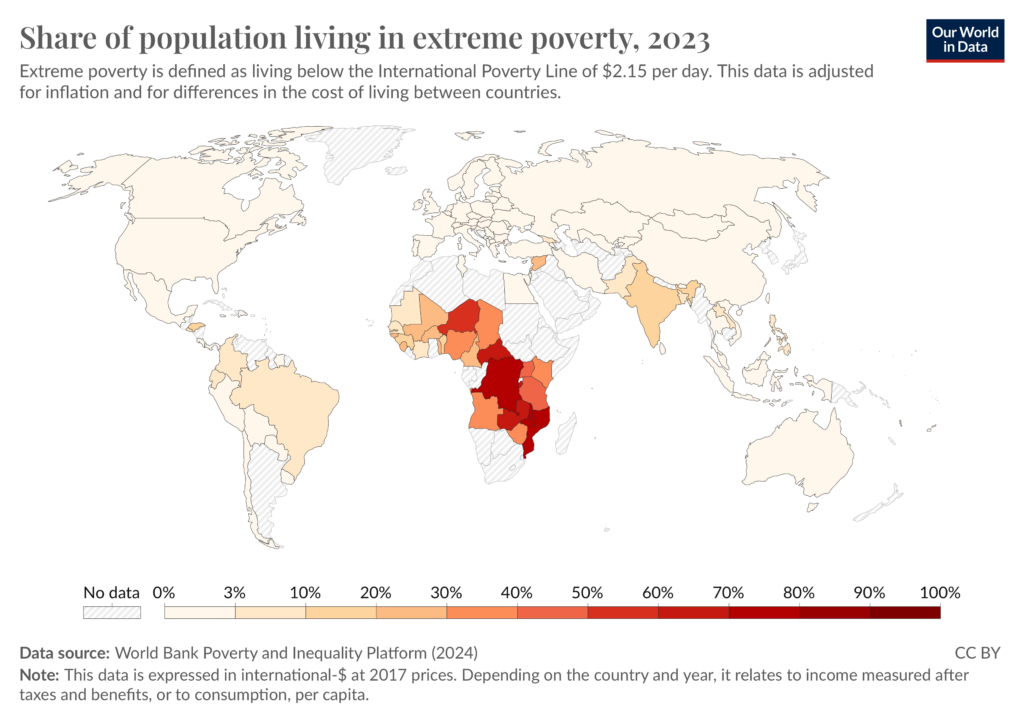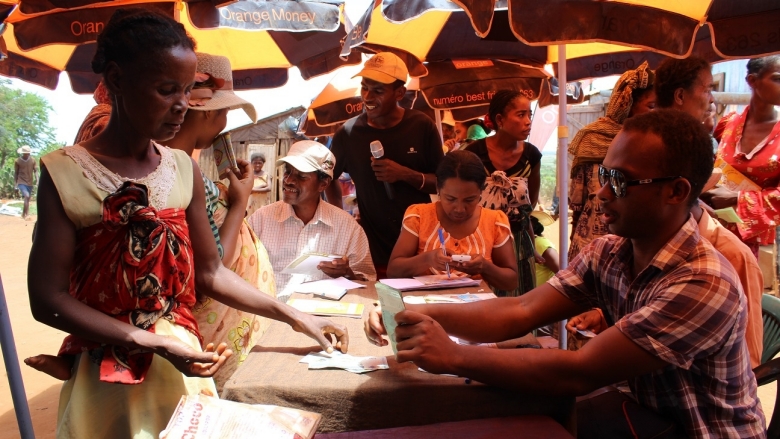Globally, poverty is one of the biggest issues faced by society. Eradicating poverty has been listed as the first goal of the United Nations’ “Millennium Development Goals” and “2030 Agenda for Sustainable Development”. While the number of people living in extreme poverty dropped by more than half between 1990 and 2019, more than 700 million people are still struggling for the most basic human needs.
The number of people living in poverty globally (1990 to 2019)
Reducing poverty entails identifying and assisting the most disadvantaged groups, enhancing essential resources and services, and providing aid to communities impacted by conflict and climate-related emergencies. Efforts to combat poverty vary widely, addressing various areas such as education, employment opportunities, community empowerment, government policies, and, importantly, social safety nets.
For sustained poverty reduction and to battle extreme poverty, it is essential for social protection systems to provide much needed social safety nets alongside other solutions, thereby reducing inequality and helping those in need to adequately provide for their families. Noteworthy components of these safety nets encompass social pensions, fee waivers, food transfers, and, notably, cash transfers.
Cash Transfer Programmes (CTPs) are one of the most effective measures in fighting poverty. These programs extend financial support in the form of Conditional Cash Transfers (CCTs) or unconditional cash transfers to families living below the poverty line. CCTs are the most prominent CTPs and they only transfer money to those who meet certain behavioral and socioeconomic criteria. For instance, enrolling their children into public schools, ensuring to receive vaccinations, getting regular check-ups at the doctor’s office, falling in a certain income bracket, and more. The implementation of such initiatives holds promise in effecting meaningful change and creating a tangible impact on the challenges posed by poverty.
The world Bank Poverty Data shows that extreme poverty continues to exist around the world and even in developed nations, a portion of the population is in need of social safety net programs like CTPs to uplift their living conditions and to drive economic growth.
Share of population living in extreme poverty, 2023
Countries like Indonesia, India, and Malawi have benefitted from CTPs through private enterprises initiatives, including Red Cross’s 510 Global, and government initiatives, such as Malawi’s ActionAid CTP, are at the forefront of driving these initiatives.
ActionAid in Malawi and their Impact
While CTPs are prevalent in countries stricken with extreme poverty, in recent years, these programmes have expanded worldwide to even more developed countries like Singapore and the Netherlands. Singapore stands out for its comprehensive social safety net programs, among which are notable initiatives like Straits Times’ School Pocket Money Fund (SPMF), ComCare, Medifund, and Silver Support.
Expanding further on Singapore’s progressive initiatives, ComCare encompasses a holistic approach by providing financial assistance, social support, and even skills training to enhance employability. It had helped over 96,040 individuals in Singapore in 2020. Medifund, on the other hand, ensures that healthcare remains accessible by assisting those facing difficulties in covering medical expenses. The Silver Support program specifically targets elderly citizens, offering a financial cushion to enhance their quality of life during retirement.
Studies indicate that the implementation of CTPs, like the ones previously described, can result in positive economic outcomes as it stimulates local GDP, wages, and household consumption. Despite these benefits, CTPs face challenges in ensuring that the resources are effectively allocated to those in need, while also maintaining an equitable distribution. This issue stems from the difficulty and expenses associated with acquiring accurate income or consumption data from those living in extreme poverty. The accuracy of targeting is crucial because if it’s inaccurate, it might lead to resources being misallocated which in turn prevents those in need from benefiting from these “cash injections”. Without precision in identifying and reaching the intended recipients, the entire effort of distributing resources becomes futile and fails to address the core objectives of CTPs. Therefore, while the primary focus of CTPs is on poverty reduction, it’s crucial that the rules for allocating their cash injections are efficient and egalitarian to maintain high effectiveness and fairness of CTPs.
To ensure that these cash injections reach the right people, Big Data and Machine Learning are employed to estimate these parameters, using diverse indicators and datasets. Yet, these predictors often come with errors, leading to imperfect targeting. To further improve accuracy, a wave of initiatives in low- and middle-income communities have turned to cutting-edge statistical methods, AI applications, and leveraging modern machine learning tools to enhance prediction accuracy to effectively close the poverty gap. Despite these advancements, targeting errors persist, sparking discussions about the fairness of the decisions made by these sophisticated techniques.
In this landscape of cash allocation, Huan Zheng et al.’s “From Targeting to Transfer: Design of Allocation Rules in Cash Transfer Programs” paves the way for understanding and better showcasing how allocation policies can be fine-tuned to balance system-wide performance and poverty reduction. Also, their refined allocation policies offer insights into dealing with prediction errors in the allocation process.
The researchers developed a robust allocation model that minimizes the squared poverty-gap index (PSI) to mitigate the negative impact of imperfect targeting. PSI is a means of measuring poverty that is widely used by researchers in the field of development economics which gauges the disparity between each recipient and the poverty line, assigning higher weightage on those who are more economically disadvantaged.
In pursuit of finding the best way to allocate cash in CTPs, the authors tested the efficacy of multiple allocations policies/models. In doing so, they used datasets from 510.global’s CTP in Malawi. Their results revealed that their proposed allocation model performed 13.82% better than benchmarks in minimizing PSI when the poverty line was set low. The study concludes that this model effectively “allocates more resources to serve the ‘right’ population.” It aids in elevating more individuals living in extreme poverty to a level above the poverty line. This study thus illuminates the path towards more efficient and equitable cash allocation policies.
As the fight against poverty continues, this study signifies a pivotal juncture in reshaping the strategies and approaches employed in CTPs, aligning them more closely with the UN’s Sustainable Development Goals and the global mission to eradicate extreme poverty.








